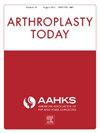A Comparison of Medial-congruent, Ultracongruent, and Cruciate-retaining Bearings Using a Single Cruciate-retaining Total Knee Design
IF 1.5
Q3 ORTHOPEDICS
引用次数: 0
Abstract
Background
Improving outcomes has driven advancements in total knee arthroplasty (TKA) bearing design. The aim of this study was to compare medial-congruent (MC), ultracongruent (UC), and cruciate-retaining (CR) TKA utilizing a single CR total knee system.
Methods
Six surgeons performed 2883 primary TKAs from 2012 to 2022 using the same implant design, comprised of 708 MC, 799 UC, and 1376 CR bearings. Prospectively collected data on clinical and patient-reported outcome measures were compared. Data analyses utilized analysis of variance tests for continuous data, chi-square tests for categorical data, and Mantel-Cox tests for survivorship analysis. MC subjects were older (MC = 67.5 vs UC = 65.3 vs CR = 66.7 years; P < .001), had lower body mass index (MC = 32.4 vs UC = 33.1 vs CR = 33.2 kg/m2; P = .04), and had shorter mean follow-up (MC = 1.2 vs UC = 2.4 vs CR = 2.9 years; P < .001).
Results
All groups experienced similar rates of 90-day complications (MC = 26/708, 3.7% vs UC = 39/799, 4.9% vs CR = 52/1376, 3.8%; P = .38) and revisions (MC = 1/708, 0.1% vs UC = 4/799, 0.5% vs CR = 5/1376, 0.4%; P = .49). Survivorship was similar at 2 years (P = .41) and above 98% at 5 years for all groups. At the 1-year follow-up, MC bearings had significantly greater Patient-Reported Outcomes Measurement Information System Global Health Physical (MC = 47.1 vs UC = 41.5 vs CR = 42.8; P < .001) and mental scores (MC = 48.9 vs UC = 41.3 vs CR = 43.7; P < .001).
Conclusions
No differences in all-cause complications or revisions were observed for MC, UC, and CR bearings using the same total knee system. Clinically important differences favoring MC bearings were found with Patient-Reported Outcomes Measurement Information System Global Health Physical scores at 1 year; however, longer follow-up is necessary to determine if this trend holds.
求助全文
约1分钟内获得全文
求助全文
来源期刊

Arthroplasty Today
Medicine-Surgery
CiteScore
2.90
自引率
0.00%
发文量
258
审稿时长
40 weeks
期刊介绍:
Arthroplasty Today is a companion journal to the Journal of Arthroplasty. The journal Arthroplasty Today brings together the clinical and scientific foundations for joint replacement of the hip and knee in an open-access, online format. Arthroplasty Today solicits manuscripts of the highest quality from all areas of scientific endeavor that relate to joint replacement or the treatment of its complications, including those dealing with patient outcomes, economic and policy issues, prosthetic design, biomechanics, biomaterials, and biologic response to arthroplasty. The journal focuses on case reports. It is the purpose of Arthroplasty Today to present material to practicing orthopaedic surgeons that will keep them abreast of developments in the field, prove useful in the care of patients, and aid in understanding the scientific foundation of this subspecialty area of joint replacement. The international members of the Editorial Board provide a worldwide perspective for the journal''s area of interest. Their participation ensures that each issue of Arthroplasty Today provides the reader with timely, peer-reviewed articles of the highest quality.
 求助内容:
求助内容: 应助结果提醒方式:
应助结果提醒方式:


